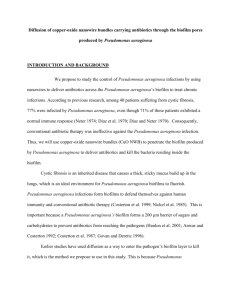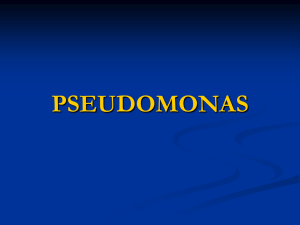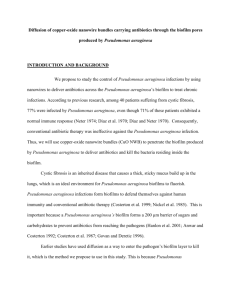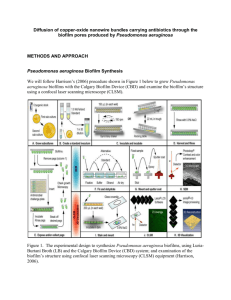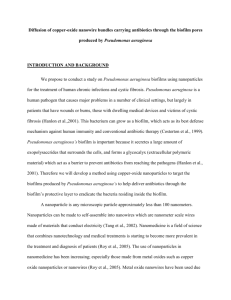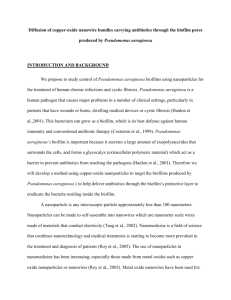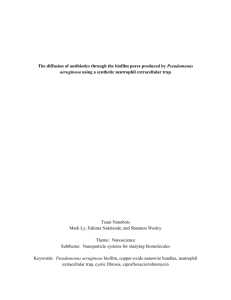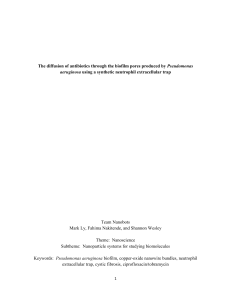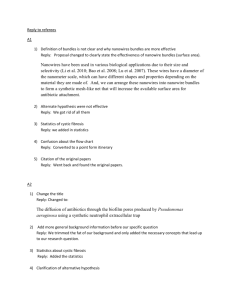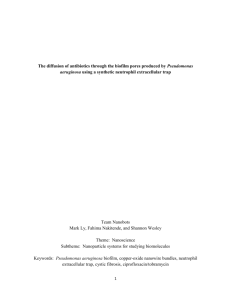Nanobots_revised_proposal
advertisement
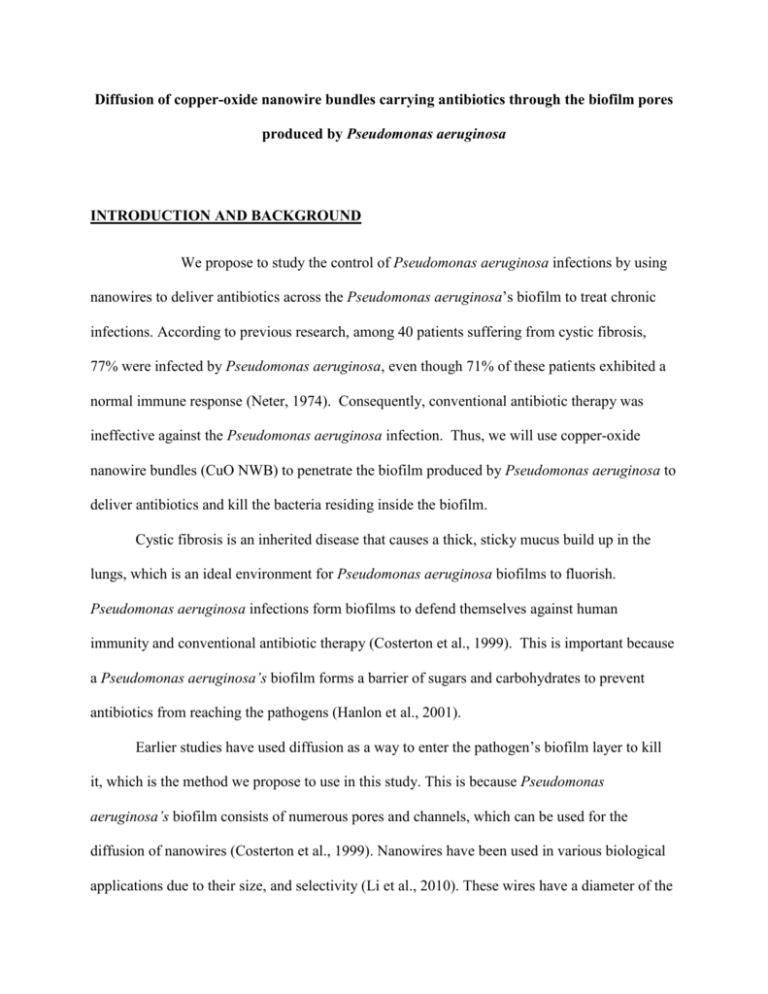
Diffusion of copper-oxide nanowire bundles carrying antibiotics through the biofilm pores produced by Pseudomonas aeruginosa INTRODUCTION AND BACKGROUND We propose to study the control of Pseudomonas aeruginosa infections by using nanowires to deliver antibiotics across the Pseudomonas aeruginosa’s biofilm to treat chronic infections. According to previous research, among 40 patients suffering from cystic fibrosis, 77% were infected by Pseudomonas aeruginosa, even though 71% of these patients exhibited a normal immune response (Neter, 1974). Consequently, conventional antibiotic therapy was ineffective against the Pseudomonas aeruginosa infection. Thus, we will use copper-oxide nanowire bundles (CuO NWB) to penetrate the biofilm produced by Pseudomonas aeruginosa to deliver antibiotics and kill the bacteria residing inside the biofilm. Cystic fibrosis is an inherited disease that causes a thick, sticky mucus build up in the lungs, which is an ideal environment for Pseudomonas aeruginosa biofilms to fluorish. Pseudomonas aeruginosa infections form biofilms to defend themselves against human immunity and conventional antibiotic therapy (Costerton et al., 1999). This is important because a Pseudomonas aeruginosa’s biofilm forms a barrier of sugars and carbohydrates to prevent antibiotics from reaching the pathogens (Hanlon et al., 2001). Earlier studies have used diffusion as a way to enter the pathogen’s biofilm layer to kill it, which is the method we propose to use in this study. This is because Pseudomonas aeruginosa’s biofilm consists of numerous pores and channels, which can be used for the diffusion of nanowires (Costerton et al., 1999). Nanowires have been used in various biological applications due to their size, and selectivity (Li et al., 2010). These wires have a diameter of the nanometer scale, which can have different shapes and properties depending on the material they are made of. In a previous study by Li et al. (2010), CuO NWBs have been used as a biosensor to detect and interact with hemoglobin. Research performed by Li et al. (2010) using CuO NWBs revealed these bundles interacted with the hemoglobin redox center deep inside a large protein shell. Thus, we suggest CuO NWBs could interact with antibiotics and penetrate through Pseudomonas aeruginosa’s biofilm layer. Metal ions have been used to kill the pathogen by diffusing metal ions such as copper, lead, nickel and others individually through the Pseudomonas aeruginos’s biofilm (Harrison et al., 2005). In addition, the results from Harrison’s (2005) experiment showed that a high concentration and long exposure time of various metal ions were able to completely eliminate the biofilm. The lengthy exposure time is a result of cationic binding of the metal ions to the biofilm, which restricted the rate of penetration (Harrison et al., 2005). We will use CuO NWBs as a carrier for our antibiotics. Copper was shown to be effective in dealing with the pathogen and biofilm of Pseudomonas aeruginosa (Harrison et al., 2005). We plan on attaching antibiotics electrostatically to the surface of the CuO NWB to increase the rate of diffusion into the biofilm. We suggest the antibiotics will occupy the positive charge on the CuO NWBs so that they do not adhere to the surface of the biofilm. Previous research performed by Walters et al. (2002) demonstrated tobramycin and ciprofloxacin eventually penetrated the biofilm, but failed to kill Pseudomonas aeruginosa once inside the biofilm. As indicated by Figure 1, both ciprofloxacin and tobramycin did not increase Pseudomonas aeruginosa’s mortality rate over a 100 hour exposure time. Figure 1. Killing of P. aeruginosa in biofilms in exposure to ciprofloxacin (A) and killing of P. aeruginosa in biofilms in exposure to tobramycin (B). Filled squares were the treatment and the unfilled were the controls (Walter et al.,2002) Thus, the ineffectiveness of these antibiotics was not because of poor penetration, but oxygen limitation and low metabolic activity inside the biofilm (Walters et al., 2002). A lack of oxygen within the biofilm either prevented Pseudomonas aeruginosa growth or the action of the antibiotics; whereas, free swimming bacterial cells were susceptible to tobramycin and ciprofloxacin (Walters et al., 2002). For these reasons, we decided to use these two antibiotics in conjunction with our CuO NWBs to kill the pathogen inside the biofilm. These bundles will not block the Pseudomonas aeruginosa biofilm pores because of their nanometer size. Therefore, oxygen transport will be restored, metabolic activity will continue as normal, and we will be able to spread the antibiotics over a larger area. So, by combining these antibiotics to our CuO NWBs we are creating a synthetic neutrophil extracellular trap (NET). In a normal immune response, white blood cells form a neutrophil net by secreting proteins and chromatin. This net traps the pathogen and prevents damage to the adjacent tissues at the site of infection. According to Brinkmann (2004), NETs bind to bacterial cells, prevent the spread of infection, and kill the pathogen using antimicrobial agents (toxins, chemicals, or antibodies). As a result of these above advantageous properties, we will use a bundle of nanowires to imitate a NET and trap the pathogen. Figure 2. Neutrophil extracellular trap (NET). According to Tirouvanziam (2007), NETs are rapidly killed by toxins released by the bacterial cells making them ineffective. This is why patients with cystic fibrosis are continuously suffering from recurring episodes of Pseudomonas aeruginosa infection. So, could CuO NWBs carrying antibiotics diffuse through the porous structure of Pseudomonas aeruginosa’s biofilm and act as a synthetic NET? We hypothesize that CuO NWBs will imitate a synthetic NET and carry antibiotics through the biofilm of Pseudomonas aeruginosa to kill the pathogen from the inside. If this synthetic NET carrying antibiotics diffuses through the biofilm successfully and if the antibiotics detach from the NET inside the biofilm, we predict no growth on the antibiotic/CuO NWB agar plates. PROPOSED RESEARCH Pseudomonas aeruginosa Biofilm Synthesis We will follow Harrison’s (2006) procedure shown in Figure 1 to grow Pseudomonas aeruginosa biofilms using the Calgary Biofilm Device (CBD) and examine the biofilm’s structure using a confocal laser scanning microscope (CLSM). Figure 1. The experimental design to synthesize Pseudomonas aeruginosa biofilms, using LuriaBurtani Broth (LB) and the Calgary Biofilm Device (CBD) system; and examination of the biofilm’s structure using confocal laser scanning microscopy (CLSM) equipment (Harrison, 2006). We will grow our Pseudomonas aeruginosa biofilms at the optimal temperature of 35℃ (Harrison et al., 2006). We will prepare a pure culture of Pseudomonas aeruginosa by streaking two LB agar plates incubated for 24 hours each: one from the stock culture and the other from a single colony on the previous plate (Fig. 1A). To grow the biofilms, a 30-fold diluted McFarland inoculum will be prepared using the Pseudomonas aeruginosa pure culture (Fig. 1B), and a CBD peg lid will be inserted into a 96-well corrugated trough containing 22 mL of inoculum in each well. Then, the corrugated trough will be placed in a humidified incubator on a rocking table (set at 3.5 rocks per min.) and incubated for 24 hours (Fig. 1C). To examine Pseudomonas aeruginosa biofilm growth, we will place a CBD peg lid into a 96-well microtiter plate containing 200 µL of 0.9% NaCl in each well for 2 min. (Fig. 1D). Next, CBD pegs are removed with flamed pliers (Fig. 1E) and placed into acridine orange stained wells of a 96-well microtiter plate. Then, each peg will be mounted on a glass coverslip with 2 drops of 0.9% NaCl (Fig. 1I) and examined under a confocal laser scanning microscope (Fig. 1J). Synthesis of copper oxide nanowires We will follow the methods outlined by Li (2010) to synthesize the copper oxide nanowire bundles. We will create a one dimensional nanowire and combine it with an aqueous solution of CuCl2. This composite solution will be vacuum filteredand dried in an oven to produce our nanowires composition. The initial template will be removed with a solution of NaOH and the copper oxide nanowire bundles will dry a final time. Creating our copper nanowire carriers takes 24 hours to complete. We will get a visual representation of our carriers by using transmission electron microscopy (TEM) to generate an image. X-ray diffraction (XRD) analysis will be used to determine the structure and correct chemical composition of our carriers. Antibiotic Coupled Nanowire Synthesis We will use electrostatic interactions to carry our two types of antibiotics, Ciproflaxin and Tombramycin, with our copper oxide nanowire carrier. We will synthesize the nanowire carriers following the methods outlined in Li (2010), but we will reduce the copper oxide to form a charged Cu2+ nanowire carrier. Our antibiotics will carry an opposite charge by salvation and interact with the charged carriers by the method of electrostatics. We will use Fourier transformIR (FT-IR) to get spectra information on our copper-oxide nanowires, antibiotic, and the combination of nanowires and antibiotics. Controls and Test Samples Pseudomonas aeruginosa biofilms will be exposed to each parameter listed in Table 1 below: Table 1. Experimental group parameters tested with Pseudomonas aeruginosa biofilms. A EXPERIMENTAL GROUP Control B Antibiotic only C Nanowire only D Nanowire + Antibiotic EXPERIMENTAL TREATMENT PARAMETERS No antibiotic No copper-oxide nanowire Antibiotic No copper-oxide nanowire No antibiotic Copper-oxide nanowire Antibiotic fused Copper-oxide nanowire EXPECTED RESULT Growth Growth No growth (magnesium toxicity) No growth (antibiotic penetration) To prepare each of our test group parameters in Table 1 above, we will follow the procedures outlined in Table 2 below: Table 2. Experimental treatment group preparations. TEST GROUP PREPARATION PROCEDURE Control Add 200 µL of 0.9% NaCl to 24 wells of a 96-well microtiter plate of a randomly selected region (1, 2, 3, or 4) (Fig. 2) Antibiotic only Add 200 µL of antibiotic to 24 wells of a 96-well microtiter plate of a randomly selected region (1, 2, 3, or 4) (Fig. 2) Nanowire only Add copper-oxide nanowires to 24 wells of a 96-well microtiter plate containing 200 µL of 0.9% NaCl of a randomly selected region (1, 2, 3, or 4) (Fig. 2) Nanowire + Antibiotic Prepare 6 dilutions of antibiotic fused copper-oxide nanowires by factors of 10 using 200 µL of 0.9% NaCl. Add 200 µL of diluted antibiotic fused copper-oxide nanowires to 4 wells of a 96-well microtiter plate of randomly selected regions (1, 2, 3, or 4) and (I, II, III, IV, V, VI) (Fig. 2) Figure 2. A microtiter plate illustrating the regions of the treatment parameters control (A), antibiotic only (B), nanowire only (C), and antibiotic fused nanowire (D) (1, 2, 3, and 4), and the antibiotic fused nanowire dilution 10-1, 10-2, 10-3, 10-4, 10-5, and 10-6 aliquots (I, II, III, IV, V, and VI) (Ceri, 1999). Sample Size We expect little to no growth once we penetrate the biofilm layer of Pseudomonas aeruginosa with our nanowires carriers. To determine the sample size (N) we will a chi-squared logistical model to determine the noncentrality parameter (λ) using the formula N = λ / w2. The effect size (w) is the effect we are interesting in detecting. With our growth and no growth model we expect to see a high effect size of 0.5. With 9 degrees of freedom in our experimental design, we obtained a noncentrality parameter of 23.5894357. The sample size that is required for our experiment is 95. We will need at least 4 MBEC plates to get the required sample size. Analysis and Interpretation We will use Harrison’s (2006) viable cell counting procedure to determine Pseudomonas aeruginosa growth following each treatment parameter discussed previously. To collect our results after conducting each treatment parameter, we will follow the procedure outlined in Figure 3 below. First, we will rinse the biofilms by placing the CBD peg lid into a 96-well microtiter plate containing 200 µL of 0.9% NaCl in each well for 2 min (Fig. 1D). Then, the CBD pegs will be removed using flamed pliers and placed in a microtiter plate containing 200 µL of 0.9% NaCl in each well (Fig. 1E). This will be followed by sonication: using an Aquasonic 250HT ultrasonic cleaner (60 Hz for 5 min.) to remove the bacterial cells from the peg surface. The bacterial cells will be serially diluted in 0.9% NaCl, plated on LB agar medium, and incubated at 35℃ for 24 hours. The following day, we will count the number of colony forming units (CFUs) on each plate and record the results. Figure 3. Diagram of experimental procedure used for group tests B, C, and D (Table 1). Step D above will incubate with antibiotics for group tests B and D and with copper oxide nanowires for group tests C and D (Herrmann, 2010). Experimental Design We propose to follow the experimental procedure outlined below: Day 0 •Grow biofilms and make copper oxide nanowires Day 1 •1: Test for copper on nanowire and combine copper nanowire with biofilm •2: Couple antibiotics to copper oxide nanowires, tests coupling, dilutes antibiotics, and combines coupled nanowires with biofilm •3: Test for biofilm growth and do antibiotic test Day 3 Day 2 •1: Records results of toxicity test •2: Records results of test route •3: Grow Biofilms and make copper oxide nanowires •1: sonicates for toxicity test •2: sonicates for test route •3: Record results of antibiotic test REFERENCES Brinkmann V, Reichard U, Goosmann C, Fauler B, UhlemannY, Weiss SD, Weinrauch Y, Zychlinsky A. 2004. Neutrophil extracellular traps kill bacteria. American Association for the Advancement of Science. 303: 1532-1535. Ceri H, Olson ME, Stremick C, Read RR, Morck D, Buret A. 1999. The Calgary biofilm device: New technology for rapid determination of antibiotic susceptibilities of bacterial biofilms. Journal of Clinical Microbiology. 37:1771-1776. Costerton JW, Stewart PS, Greenberg EP. 1999. Bacterial biofilms: A common cause of persistent infections. Science. 284: 1318-22. Hanlon WG, Denyer Ps, Olliff JC, Ibrahim JL. 2001. Reduction in exopolysaccharide viscosity as an aid to bacteriophage penetration through Pseudomonas aeruginosa biofilms. American Society for Microbiology. 67: 2746-53. Harrison JJ, Turner RJ, Ceri H. 2005. Persister cells, the biofilm matrix and tolerance to metal cations in biofilm and planktonic Pseudomonas aeruginosa. Biofilm Research Group. University of Calgary. 7: 981-94. Harrison JJ, Ceri H, Yerly J, Stremick CA, Hu Y, Martinuzzi R, Turner RJ. 2006. The use of microscopy and three-dimensional visualization to evaluate the structure of microbial biofilms cultivated in the Calgary biofilm device. Biological Procedures Online. 8:194215. Herrmann G, Yang L, Wu H, Song Z, Wang H, Hoiby N, Ulrich M, Molin S, Riethmuller J, Doring G. 2010. Colistin-tobramycin combinations are superior to monotherapy concerning the killing of biofilm Pseudomonas aeruginosa. The Journal of Infectious Diseases. 202:1585-1592. Li Y, Zhang Q, Li J. 2010. Direct electrochemistry of hemoglobin immobilized in CuO nanowire bundles. Talanta. 83: 162-66. Neter E. 1974. Pseudomonas aeruginosa infection and humoral antibody response of patients with cystic fibrosis. The Journal of infectious diseases. 130: 132-133. Tang Z, Kotov AN, Giersig M. 2002. Spontaneous organization of single ctde nanoparticles into luminescent nanowires. Science, new series. 297: 237-40. Tirouvanziam.R, Gernez Y, Conrad KC, Moss BR, Schrijver I, Dunn EC, Davies AZ, Herzenberg AL, Herzenberg AL. 2007. Profound functional and signaling changes in viable inflammatory neutrophills. National Academy of Science. 105: 4335-4339. Roy I, Ohulchanskyy YT, Bharali JD, Pudavar EH, Mistretta AR, Kaur N, Prasad NP, Rentzepis MP. 2005. Optical tracking of organically modified silica nanoparticles as DNA carriers. A nonviral, nanomedicine approach for gene delivery. National Academy of Science of the United States of America. 102: 279-84. Walters CM, Roe F, Bugnicourt A, Franklin MJ, Stewart SP. 2003. Contributions of antibiotic penetration, oxygen limitation, and low metabolic activity to tolerance of Pseudomonas aeruginosa biofilms to ciprofloxacin and tobramyacin. American Society for Microbiology. 47: 317-23.
